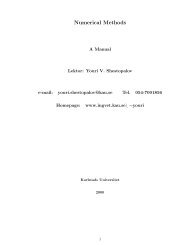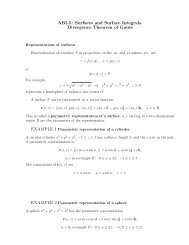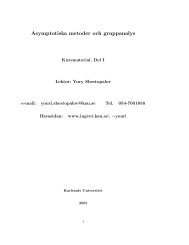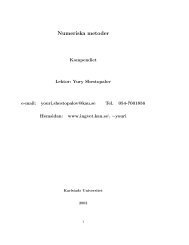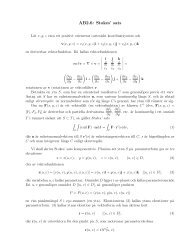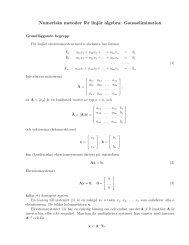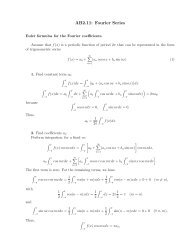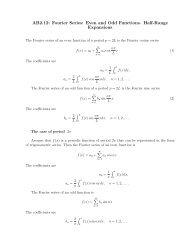In terms of the summation operators, this systems can be represented asLξ + Aξ = f; ξ = (ξ 0 , ξ 1 , . . . , ξ n , . . .) ∈ h 2 ; f = (f 0 , f 1 , . . . , f n , . . .) ∈ h 4 .Here, operators L and A are defined byL = {l nj } ∞ n,j=0, l nj = 0, n ≠ j; l 00 = ln 2; l nn = 1 , n = 1, 2, . . . ;nwhereA = {a nj } ∞ n,j=0,a nj = ε nj∫ ∫Π 1⎧⎨ 1, n = j = 0,ε nj = 2, n ≤ 1, j ≤ 1,⎩ √2, for other n, j.dxdsN(q)T n (x)T j (s)π 2 p 1 (x)p 1 (s) , (373)Lemma 7 Let N(q) satisfy the continuity conditions formulated in (367). Then∞∑n=1,j=0|a nj | 2 n 4 +∞∑j=0|a 0j | 2 1ln 2 2 ≤ C 0, (374)whereC 0 = 1ln 2 2∫1∫1∣−1 −1N(q)dxπp 1 (x)2∣∫ ∫dsπp 1 (s) +Π 1p 2 1(x) |(p 1 (x)N ′ x) ′ x| 2 dxdsπ 2 p 1 (x)p 1 (s) . (375)✷ Expand a function of two variables belonging to the weighted space L 2 [Π 1 , p −11 (x)p −11 (s)] inthe double Fourier–Chebyshev series using the Fourier–Chebyshev system {T n (x)T m (s)}:where∞∑ ∞∑−p 1 (x)(p 1 (x)N x(q)) ′ ′ x = C nm T n (x)T m (s),n=0 m=0C nm = − ε2 nmπThe Bessel inequality yields= ε2 nmπ∫1−1∫ 1−1∫= nε2 1nmπ 2= n2 ε 2 nmπ 2−1T m (s) dsp 1 (s)Π 1∫1−1∫ 1T n (x)(p 1 (x)N ′ x(q)) ′ xdxT m (s) ds Tp 1 (s)n(x)p ′ 1 (x)N x(q)dx′−1∫1T m (s)p 1 (s) ds U n (x)N x(q)dx′−1∫ ∫N(q)T n (x)T m (s)dxds = n 2 ε nm a nm .p 1 (x)p 1 (s)∞∑ ∞∑∫ ∫n 4 π 2 |a nm | 2 ≤ p 2 1(x)|[p 1 (x)N x(q)] ′ ′ x| 2 dxdsn=1 m=0p 1 (x)p 1 (s) .Π 178
Let us expand the functiong(s) = 1ln 2∫1−1N(q)dxπ 2 p 1 (x)in the Fourier–Chebyshev series. Again, due to the Bessel inequality, we obtain1ln 2 2∞∑|a 0m | 2 ≤ 1 ∫1∫1m=0 ln 2 2 ∣−1 −1N(q)dsπp 1 (x)2∣dsπp 1 (s) .21 Galerkin methods and basis of Chebyshev polynomialsWe describe the approximate solution of linear operator equations considering their projectionsonto finite-dimensional subspaces, which is convenient for practical calculations. Below, it isassumed that all operators are linear and bounded. Then, the general results concerning thesubstantiation and convergence the Galerkin methods will be applied to solving logarithmicintegral equations.Definition 10 Let X and Y be the Banach spaces and let A : X → Y be an injective operator.Let X n ⊂ X and Y n ⊂ Y be two sequences of subspaces with dim X n = dim Y n = n andP n : Y → Y n be the projection operators. The projection method generated by X n and P napproximates the equationAϕ = fby its projectionP n Aϕ n = P n f.This projection method is called convergent for operator A, if there exists an index N such thatfor each f ∈ Im A, the approximating equation P n Aϕ = P n f has a unique solution ϕ n ∈ X n forall n ≥ N and these solutions converge, ϕ n → ϕ, n → ∞, to the unique solution ϕ of Aϕ = f.In terms of operators, the convergence of the projection method means that for all n ≥N, the finite-dimensional operators A n := P n A : X n → Y n are invertible and the pointwiseconvergence A −1n P n Aϕ → ϕ, n → ∞, holds for all ϕ ∈ X. In the general case, one may expectthat the convergence occurs if subspaces X n form a dense set:inf ‖ψ − ϕ‖ → 0, n → ∞ (376)ψ∈X nfor all ϕ ∈ X. This property is called the approximating property (any element ϕ ∈ X can beapproximated by elements ψ ∈ X n with an arbitrary accuracy in the norm of X). Therefore,in the subsequent analysis, we will always assume that this condition is fulfilled. Since A n =P n A is a linear operator acting in finite-dimensional spaces, the projection method reduces tosolving a finite-dimensional linear system. Below, the Galerkin method will be considered asthe projection method under the assumption that the above definition is valid in terms of theorthogonal projection.Consider first the general convergence and error analysis.79✷
- Page 1 and 2:
Karlstad UniversityDivision for Eng
- Page 3 and 4:
10.5 The Hilbert-Schmidt theorem .
- Page 5 and 6:
2 Notion and examples of integral e
- Page 7 and 8:
Subtracting termwise we obtain an o
- Page 9 and 10:
with the initial conditiony(x 0 ) =
- Page 11 and 12:
Example 7 The space C[a, b] of cont
- Page 13 and 14:
where the kernel K(x, y) is a conti
- Page 15 and 16:
and so on, obtaining for the (n + 1
- Page 17 and 18:
Thus the common term of the series
- Page 19 and 20:
Proof. To prove the theorem, it is
- Page 21 and 22:
Theorem 9 (Superposition principle)
- Page 23 and 24:
A, being completely continuous in t
- Page 25 and 26:
These conditions are equivalent to
- Page 27 and 28: In particular, if λ is a regular v
- Page 29 and 30: so thatanda 11 =a 12 =a 21 =a 22 =f
- Page 31 and 32: Therefore the solution isφ(x) = f(
- Page 33 and 34: ∫ bc n = . . .a∫ ba∣K(y 1 , y
- Page 35 and 36: is called the Euclidian space.In a
- Page 37 and 38: Now note that K N (x, y) in (189) i
- Page 39 and 40: Proof. Assume that y n ∈ Im T and
- Page 41 and 42: We see that, on the one hand, vecto
- Page 43 and 44: Multiply equality (213) by ¯φ 0 a
- Page 45 and 46: Replacing x by y abd vice versa, we
- Page 47 and 48: 12 Harmonic functions and Green’s
- Page 49 and 50: Since on Ω(x, r) we havegrad y Φ(
- Page 51 and 52: From Green’s first formula applie
- Page 53 and 54: which proves the continuity of the
- Page 55 and 56: where B 1 is a constant taken accor
- Page 57 and 58: Theorem 36 The operators I − K 0
- Page 59 and 60: Theorem 41 Let D ∈ R 2 be a domai
- Page 61 and 62: n = 2 π∫1−1f(x)U n (x) √ 1
- Page 63 and 64: A similar statement is valid for th
- Page 65 and 66: In some cases one can determine the
- Page 67 and 68: Coefficient a 0 vanishes because (s
- Page 69 and 70: Expand the right-hand side in the C
- Page 71 and 72: We see that the equation has the un
- Page 73 and 74: or, in other notation,andorL = {l n
- Page 75 and 76: where T n (x) = cos(n arccos x) are
- Page 77: and the integral equationwhereΦ N
- Page 81 and 82: Assume that X n and Y n are the spa




